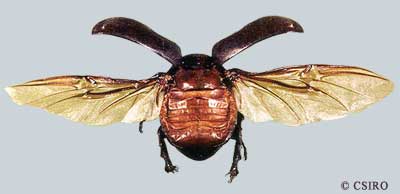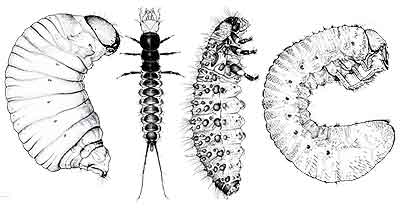|
Coleoptera:
beetles and weevils
Characteristics
Beetles
constitute the largest and most diverse order of insects on earth,
making up about 30% of all animals. There are over 300 000 species
of beetles worldwide and over 28 000 species spread across 117 families
in Australia. Beetles come in a variety of shapes and colours and
can range from 0.4 to about 80 millimetres in length. Due to the
variation within the order it is difficult to give a general description
however all beetles characteristically have the following features:
|
|
|
Elytra
raised to reveal the membranous hindwings
|
|
- 2 pairs
of wings. Forewings hardened, hind wings membranous
- Mandibulate
mouthparts which are designed for biting and chewing
- Antennae
present in a variety of forms
|
The forewings
of beetles are heavily sclerotised
and form protective covers over the hind wings. The forewings are
called elytra
and Coleoptera means 'sheath wings' i.e. the hard sheath-like elytra
over the soft hind wings. The elytra are not used in flight but
are lifted out of the way of the hind wings. At rest the elytra
meet in a straight line down the middle of the back. The elytra
may completely cover the abdomen or may be shorter exposing part
of the abdomen. The hind wings are membranous and are used for flight.
At rest they are folded protectively under the elytra. Some species
do not have hind wings and their elytra are generally fused together.
Coleoptera are
the only order of insects that have elytra.
This adaptation has enabled them to expand into many habitats such
as leaf litter, logs and soil, that would otherwise damage the wings
of less well protected insect groups. At first glance beetles may
appear to have only 2 body segments because the elytra may cover
most of the thorax
and abdomen.
However if you capture a beetle and turn it over you will be able
to see the segments that are hidden by the elytra.
Larval Characteristics:
The larvae of beetles also come in a variety of shapes and sizes
depending on where they live and what they eat. Larvae generally
appear grub-like with a well-defined head capsule, which may be
highly sclerotised.
They have short antennae and usually have chewing mouthparts. The
legs may be present or absent.
|
|
|
Various
larval types: Curculionidae, Carabidae, Chrysomelidae, Scarabaeidae
|
Beetles are
often confused with cockroaches
(Blattodea) or bugs
(Hemiptera) but can be distinguished from the former
by their forewings which are modified into elytra
and meet in a straight line down the back and from the later by
their chewing rather than sucking mouthparts.
Life Cycle
Beetles
have a complete
life cycle and development may take anywhere from a few
weeks to several years. Eggs are usually laid on or near the food
source such as in the soil or on a host plant, depending on the
species. The number of eggs laid will depend on the species and
may range from one or two up to hundreds. After hatching the larvae
develop through a series of growth stages known as instars
(usually 3 to 5) before pupating
into adults.
Feeding
Beetles
are generally herbivores,
scavengers
or predators,
although some adult beetles do not feed at all. The greatest numbers
are plant feeders in one form or another, such as nectar feeders
(some Buprestidae), foliage eaters (Chrysomelidae), seed-eaters
(many Curculionidae) or timber (Cerambycidae) or bark borers (Scolytidae).
Others may feed on rotting wood (Lucanidae), carrion (Silphidae),
dung (some Scarabaeidae), fungi or leaf litter. Some species are
also predators (Carabidae) of other invertebrates. The feeding habits
between larvae and adults may be the same or can vary. For example
some beetle species are predatory when in the larval stage and plant-feeders
when adults.
Habitat
Beetles
can be found in almost all available habitats throughout Australia.
Most are terrestrial though many families are largely or wholly
freshwater in habit and some can be found living in marginal marine
environments. In terrestrial environments beetles can be found living
in soil, humus and leaf litter; under the bark of living and dead
trees or in decomposing wood; under stones and logs; in dung, carrion
and the fruiting bodies of many types of fungi. Some species live
solely in caves while others live in the nests of vertebrates or
social insects such as termites or in man-made environments such
as silos where grains are stored.
In aquatic environments
beetles can exploit many habitats ranging from temporary pools or
mountain streams to brackish waters and mud flats. Some can be found
living in the sand, gravel or mud at the edges of streams and ponds
and in the high-water debris on the seashore or among the rocks
and coral in the intertidal zone.
|


